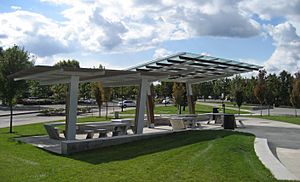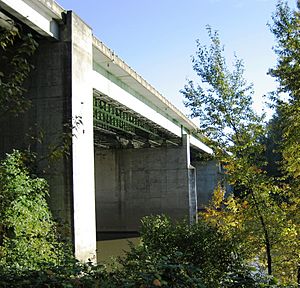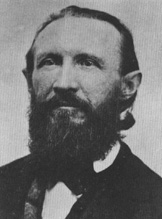Wilsonville, Oregon facts for kids
Quick facts for kids
Wilsonville, Oregon
|
||
|---|---|---|
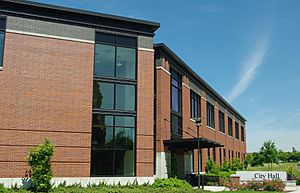
City Hall
|
||
|
||
| Motto(s):
Serving the Community with Pride
|
||
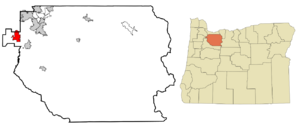
Location in Oregon
|
||
| Country | United States | |
| State | Oregon | |
| Counties | Clackamas, Washington | |
| Incorporated | October 10, 1968 | |
| Named for | Charles Wilson | |
| Government | ||
| • Type | Council-manager | |
| Area | ||
| • Total | 7.76 sq mi (20.09 km2) | |
| • Land | 7.55 sq mi (19.56 km2) | |
| • Water | 0.21 sq mi (0.53 km2) | |
| Elevation | 177 ft (54 m) | |
| Population
(2020)
|
||
| • Total | 26,664 | |
| • Density | 3,531.19/sq mi (1,363.33/km2) | |
| Time zone | UTC-8 (Pacific) | |
| • Summer (DST) | UTC-7 (Pacific) | |
| ZIP code |
97070
|
|
| Area code(s) | 503 and 971 | |
| FIPS code | 41-82800 | |
| GNIS ID | 2412277 | |
Wilsonville is a city in Oregon, located in both Clackamas and Washington counties. It started as 'Boones Landing' because of Boones Ferry, which crossed the Willamette River. The community was renamed Wilsonville in 1880.
The city officially became a city in 1969 with about 1,000 people. By 2020, its population had grown to 26,664. Wilsonville is part of the larger Portland metropolitan area. It includes planned communities like Charbonneau and Villebois.
Interstate 5 runs right through Wilsonville, including the Boone Bridge over the Willamette River. The city has its own public transportation system called South Metro Area Regional Transit (SMART). This system connects to Portland's TriMet services, including the WES Commuter Rail.
Students in Wilsonville attend schools in the West Linn-Wilsonville and Canby school districts. Wilsonville High School is the main high school. You can also find satellite campuses for Clackamas Community College and Oregon Tech here.
Wilsonville has a council-manager government. The city manages its own library, public works, and parks. Fire and police services are provided by other regional agencies. Many technology companies, like Siemens Digital Industries Software, are located in Wilsonville. Stream Global Services is the city's largest employer.
Contents
Exploring Wilsonville's Past
Wilsonville has a rich history that began with a ferry and grew into a bustling city.
Early Beginnings and Boones Ferry
Alphonso Boone, a grandson of the famous Daniel Boone, settled here in 1846. He started the Boones Ferry across the Willamette River in 1847. This ferry led to the community being called Boones Landing.
At first, this area was part of Yamhill County. But in 1855, it became part of Clackamas County. The first post office opened in 1876, still named Boones Ferry.
Becoming Wilsonville
On June 3, 1880, the community was officially named Wilsonville. It was named after Charles Wilson, who was the first postmaster. That same year, the first school, Wilsonville Grade School, opened. It was a single-room building.
By 1890, the railroad reached town. Wilsonville had a train station, hotels, and other businesses. In 1897, several local school districts merged into one larger district. A railroad bridge for the Oregon Electric Railway was built across the river in 1906. Train service to Salem began in 1908.
Growth and Changes
A new Methodist church was built in 1910 and is still standing today. In 1912, a new two-room school replaced the old one. The Boones Ferry stopped running in 1954 when the Boone Bridge opened for what is now Interstate 5.
In 1961, Dammasch State Hospital, a mental hospital, opened nearby. The Gordon House, designed by famous architect Frank Lloyd Wright, was built in 1963. It was later moved to the Oregon Garden. Wilsonville became an official city on October 10, 1968, with about 1,000 residents. In 1971, the planned community of Charbonneau joined the city.
Tektronix built a large campus in the city starting in 1973. This campus was later sold to Xerox. Wilsonville's city hall moved to a new building in 1983. The city's population grew to 7,106 by 1990. The Town Center Shopping Center opened in 1991.
Recent Developments
Author Walt Morey, known for "Gentle Ben," owned land in Wilsonville. After he passed away, a housing area called Morey's Landing was built there. The children's section of the library and Walt Morey Park are named after him.
Dammasch State Hospital closed in 1995. The land was later redeveloped into Villebois, a new residential community. Also in 1995, Wilsonville High School opened, becoming the city's first high school. A new water treatment plant opened in 2002 to ensure the city had enough water.
The Wilsonville Public Library was greatly expanded in 2002. In 2006, a new city hall building opened. During the Great Recession, some businesses closed or moved. However, Oregon Institute of Technology took over a building in 2010 for its Portland campus.
New schools like Lowrie Primary School opened in 2012. The Villebois Community Center was finished in 2013. In 2021, Fry's Electronics closed its store. Other local places like World of Speed museum and the bowling alley also closed due to the COVID-19 pandemic. In June 2021, Wilsonville experienced its highest recorded temperature of 116 °F (47 °C). The city's only movie theater closed in July 2023.
Wilsonville's Location and Landscape
Wilsonville is a city with diverse natural features and a well-organized layout.
Where is Wilsonville?
Wilsonville is on the southern edge of the Portland metropolitan area. It sits about 154 feet (47 m) above sea level. Most of the city is in Clackamas County, but a northern part is in Washington County. It's located on the north side of the Willamette River, where Boones Ferry used to operate.
Nearby cities include Tualatin to the north, Sherwood to the northwest, and Canby and Aurora to the southeast. Newberg is about 14 miles west. The Willamette River separates most of the city from Charbonneau, a planned community within Wilsonville.
Waterways and Natural Areas
The city covers about 7.42 square miles (19.22 km2), with most of it being land. Besides the Willamette River, there are several creeks like Arrowhead Creek, Meridian Creek, and Boeckman Creek. Boeckman and Coffee Lake creeks handle most of Wilsonville's rainwater runoff. Coffee Lake Creek is on the west side and includes the Coffee Lake Wetlands. The Chehalem Mountains are to the west, but most of Wilsonville itself is flat.
Neighborhoods and Planning
Wilsonville divides itself into 16 planning areas, from A to P. Within these areas are many different neighborhoods. For example, the Villebois development covers several areas. Other neighborhoods include Charbonneau, Wilsonville Meadows, and Old Town. Wilsonville's Old Town is the oldest neighborhood. It's located near where the old Boones Ferry used to land.
Understanding Wilsonville's Climate
Wilsonville has a Marine west coast climate, like much of the Willamette Valley.
Weather Patterns
Summers in Wilsonville are usually warm. The Pacific Ocean helps keep temperatures mild all year. Most of the rain falls during the mild to cool winter months, from November to March. July and August are the warmest months, with average high temperatures around 87 °F (31 °C). December is the coolest month, with average lows around 34 °F (1 °C). December is also the wettest month, with about 6.67 inches (169 mm) of rain.
Temperature Extremes
The highest temperature ever recorded in Wilsonville was 116 °F (47 °C) on June 28, 2021. This happened during a record-breaking heatwave. The lowest temperature ever recorded was −15 °F (−26 °C) on December 23, 1998.
| Climate data for Wilsonville, Oregon | |||||||||||||
|---|---|---|---|---|---|---|---|---|---|---|---|---|---|
| Month | Jan | Feb | Mar | Apr | May | Jun | Jul | Aug | Sep | Oct | Nov | Dec | Year |
| Record high °F (°C) | 65 (18) |
72 (22) |
78 (26) |
87 (31) |
101 (38) |
116 (47) |
104 (40) |
105 (41) |
105 (41) |
95 (35) |
72 (22) |
67 (19) |
116 (47) |
| Mean daily maximum °F (°C) | 48 (9) |
52 (11) |
57 (14) |
61 (16) |
68 (20) |
74 (23) |
81 (27) |
82 (28) |
76 (24) |
64 (18) |
53 (12) |
46 (8) |
64 (18) |
| Mean daily minimum °F (°C) | 36 (2) |
36 (2) |
39 (4) |
42 (6) |
47 (8) |
52 (11) |
55 (13) |
55 (13) |
51 (11) |
44 (7) |
40 (4) |
34 (1) |
44 (7) |
| Record low °F (°C) | 8 (−13) |
8 (−13) |
20 (−7) |
19 (−7) |
29 (−2) |
34 (1) |
41 (5) |
37 (3) |
30 (−1) |
25 (−4) |
14 (−10) |
−15 (−26) |
−15 (−26) |
| Average precipitation inches (mm) | 6.17 (157) |
4.74 (120) |
4.55 (116) |
3.24 (82) |
2.52 (64) |
1.86 (47) |
0.60 (15) |
0.64 (16) |
1.54 (39) |
3.58 (91) |
6.56 (167) |
6.62 (168) |
42.62 (1,083) |
| Source: The Weather Channel | |||||||||||||
People and Population
Wilsonville has grown a lot since it became a city.
| Historical population | |||
|---|---|---|---|
| Census | Pop. | %± | |
| 1970 | 1,001 | — | |
| 1980 | 2,920 | 191.7% | |
| 1990 | 7,106 | 143.4% | |
| 2000 | 13,991 | 96.9% | |
| 2010 | 19,509 | 39.4% | |
| 2020 | 26,664 | 36.7% | |
| U.S. Decennial Census | |||
Many families live in Wilsonville because it's a good halfway point for jobs in Salem and Portland. When Wilsonville became a city in 1969, it had about 1,000 residents. By the 2020 census, the population reached 26,664. This number includes people living at the Coffee Creek Correctional Facility, which opened in 2001.
Wilsonville's Economy
Wilsonville's location near Interstate 5 makes it a great place for businesses.
Major Companies and Employers
Many companies have their main offices or large facilities in Wilsonville. These include design software maker Mentor Graphics and imaging systems manufacturer FLIR Systems.
Xerox, a company that makes copiers and printers, has a large facility here. It's one of the city's biggest employers. Xerox, Mentor Graphics, and FLIR are all located close to each other. InFocus and Mentor Graphics were both started by former employees of Tektronix.
Wilsonville has many industrial parks with manufacturing and distribution centers. Other large employers include Tyco Electronics, Sysco, Rockwell Collins, and Rite Aid. Coca-Cola also has a bottling plant in the city.
Shopping and Retail
Most of Wilsonville's shopping areas are along Wilsonville Road near Interstate 5. This includes the Town Center Shopping Center. Fry's Electronics, which was once a major employer, closed its store in 2021.
Culture and Community Life
Wilsonville offers many ways for residents to connect and enjoy themselves.
Media and Information
People in Wilsonville can access many radio and television stations from the Portland area. They also read regional newspapers like The Oregonian. The local newspaper is the Wilsonville Spokesman, which is published once a week.
Parks and Recreation
The Wilsonville Public Library opened in 1982. It's part of the Library Information Network of Clackamas County. The library is next to Wilsonville Memorial Park, which is the city's largest and oldest park. Memorial Park has water features, sports fields, and a barn for meetings.
Town Center Park also has a water feature and a visitor's center. Other parks in the city include River Fox Park, Montebello Park, and Boones Ferry Park. Boones Ferry Park is located where the old Boones Ferry used to land on the Willamette River.
Community Events
The Wilsonville Community Center hosts classes and programs for the community. Each May, Wilsonville holds an annual arts fair called the Wilsonville Festival of Arts. Another yearly event is Wilsonville Celebration Days, which started in 2000. A farmers' market is held on Thursdays from May to October in the Villebois area.
The Charbonneau Golf Club is the only golf course in the city. Wilsonville is also part of the Willamette Greenway, which offers open spaces and trails along the river.
Learning and Education
Wilsonville has several schools and colleges for students of all ages.
Local School Districts
Most of Wilsonville is in the West Linn-Wilsonville School District (WLWSD). However, areas south of the Willamette River are in the Canby School District. Some areas to the west are in the Sherwood School District.
- Primary Schools: Lowrie Primary, Boeckman Creek, and Boones Ferry primary schools serve students from kindergarten to 5th grade in WLWSD.
- Middle Schools: Students in grades 6–8 attend Inza R. Wood Middle School and Meridian Creek Middle School.
- High Schools: High school students attend Wilsonville High School or the Arts and Technology High School (ArtTech).
Neither the Canby nor Sherwood districts have schools within Wilsonville itself.
Higher Education Opportunities
Wilsonville is part of the Clackamas Community College District. The college has a satellite campus in the city. The Oregon Institute of Technology also has its Portland area campus in Wilsonville.
School Mascots and Fun Facts
- Boeckman Creek Primary School opened in 1995 and its mascot is the Bobcats.
- Boones Ferry Primary School opened in 2000 and its mascot is the Dragonflies.
- Wood Middle School opened in 1986 and its mascot is the Wolverines.
- Meridian Creek Middle School opened in 2016 and its mascot is the Mustangs.
- Wilsonville High School opened in 1999 and its mascot is the Wildcats.
- The ArtTech charter high school opened in 2001.
Getting Around Wilsonville
Wilsonville has a good transportation system that connects it to other areas.
Roads and Highways
Interstate 5 runs north-south through the city. It crosses the Willamette River on the Boone Bridge. Wilsonville has two exits from I-5 north of the river. Boeckman Road is the only other street that crosses I-5, connecting the east and west parts of the city. Main roads in Wilsonville include Wilsonville Road, Boones Ferry Road, and Parkway Avenue.
Public Transportation
Wilsonville operates its own transit service called South Metro Area Regional Transit (SMART). SMART connects with transit services in Salem and Canby, and with Portland's TriMet. The Westside Express Service (WES), a commuter train to Beaverton, started in 2009. Wilsonville Station is the southern end of this train line and a main hub for SMART buses.
Rail and Air Travel
Freight trains use the same tracks as the WES commuter rail. These tracks cross the Willamette River on the Portland and Western Railroad Bridge. Wilsonville does not have its own airport. The closest public airport is Aurora State Airport to the south. The closest commercial airport is Portland International Airport, about 17 miles north.
Famous People from Wilsonville
Many interesting people, from politicians to athletes and authors, have called Wilsonville home.
- Politicians: Former governor George Law Curry, Congresswoman Edith Green, and former mayor Jerry Krummel.
- Athletes: Football player Derek Devine, professional golfer Brian Henninger, and baseball player and manager Del Baker.
- Authors: Children's author Walt Morey.
- Actors: Frank Cady and current resident Henry Thomas.
Sister City Connection
Wilsonville has one special international friendship.
Friendship with Kitakata, Japan
Wilsonville has a sister city relationship with Kitakata, Japan. This connection began in 1988. Kitakata is located in the Fukushima province of Japan. In 1994, Wilsonville's mayor visited Kitakata. In 2008, Kitakata's mayor visited Wilsonville to celebrate 20 years of their friendship.
See also
 In Spanish: Wilsonville (Oregón) para niños
In Spanish: Wilsonville (Oregón) para niños






